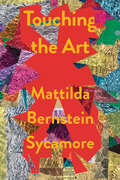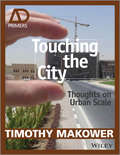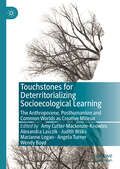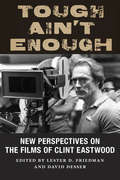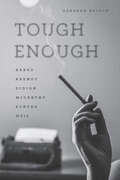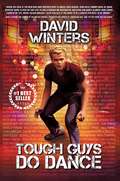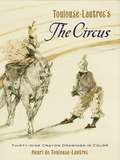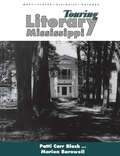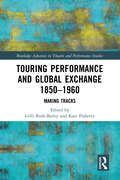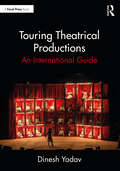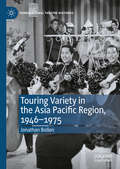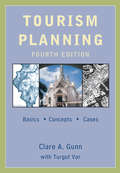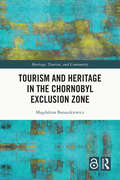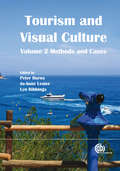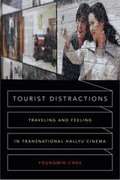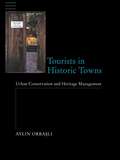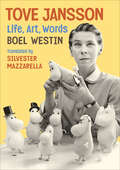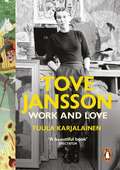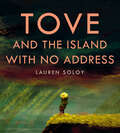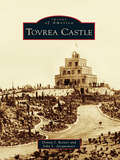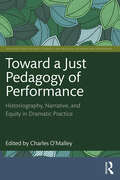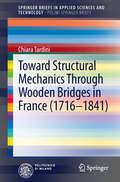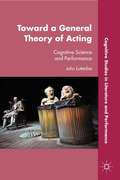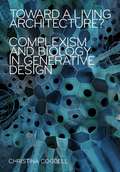- Table View
- List View
Touching the Art
by Mattilda Bernstein SycamoreA daringly observant memoir about intergenerational trauma, fine art, and compartmentalization from a returning Soft Skull author and Lambda Literary Award winnerA mixture of memoir, biography, criticism, and social history, Touching the Art is queer icon and activist Mattilda Bernstein Sycamore&’s interrogation of the possibilities of artistic striving, the limits of the middle-class mindset, the legacy of familial abandonment, and what art can and cannot do.Taking the form of a self-directed research project, Sycamore recounts the legacy of her fraught relationship with her late grandmother, an abstract artist from Baltimore who encouraged Mattilda as a young artist, then disparaged Mattilda&’s work as &“vulgar&” and a &“waste of talent&” once it became unapologetically queer.As she sorts through her grandmother Gladys&’s paintings and handmade paperworks, Sycamore examines the creative impulse itself. In fragments evoking the movements of memory, she searches for Gladys&’s place within the trajectories of midcentury modernism and Abstract Expressionism, Jewish assimilation and white flight, intergenerational trauma and class striving.Sycamore writes, &“Art is never just art, it is a history of feeling, a gap between sensations, a safety valve, an escape hatch, a sudden shift in the body, a clipboard full of flowers, a welcome mat flipped over and back, over and back, welcome.&”Refusing easy answers in search of an embodied truth, Sycamore upends propriety to touch the art and feel everything that comes through.
Touching the City: Thoughts on Urban Scale (Architectural Design Primer)
by Timothy MakowerScale in cities is relative and absolute. It has the ability to make us feel at home in the world or alien from it; connected or disconnected. Both large and small scale in cities can be beautiful; both are right, neither is wrong. Whilst accepting that prescription is no answer, 'getting the scale right' – at an intuitive and sensual level – is a fundamental part of the magic of architecture and urban design. Touching the City explores how scale is manifested in cities, exploring scale in buildings, in the space between them and in their details. It asks how scale makes a difference. Travelling from Detroit to Chandigarh, via New York, London, Paris, Rome and Doha, Tim Makower explores cities with the analytical eye of a designer and with the experiential eye of the urban dweller. Looking at historic cities, he asks what is good about them: what can we learn from the old to inform the new? The book zooms in from the macro scale of surfing Google Earth to micro moments such as finding fossils in a weathered wall. It examines the dynamics and movement patterns of cities, the making of streets and skylines, the formation of thresholds and facades, and it also touches on the process of design and the importance of drawing. As the book's title, Touching the City, suggests, it also emphasises the tactile – that the city is indeed something physical, something we can touch and be touched by, alive and ever changing.
Touchstones for Deterritorializing Socioecological Learning: The Anthropocene, Posthumanism and Common Worlds as Creative Milieux
by Wendy Boyd Angela Turner Amy Cutter-Mackenzie-Knowles Alexandra Lasczik Judith Wilks Marianne LoganThis book focuses on socioecological learning through the touchstone concepts of the Anthropocene, the Posthuman and Common Worlds as Creative Milieux. The editors and contributors explore, situate and interrogate social learning through transdisciplinary positionings, exemplars and theories. The eclectic and cohesive chapters unfold as a journey that may inspire innovative and unique understandings of the socioecological learner: insights that will surely be paramount as we careen towards the 22nd century and all of its as-yet-unknown challenges. Offering tangible and nuanced practice for educational leadership in socioecological learning, this pioneering book will be of interest and value to researchers and educators at all levels. This volume is sure to appeal to students and scholars of socioecological learning as well as the Anthropocene and the Posthuman.
Tough Ain't Enough: New Perspectives on the Films of Clint Eastwood
by Murray Pomerance Stephen Prince Jonathan Kirshner David Sterritt Diane Carson Lucy Bolton Professor Lester D. Friedman Professor David Desser Alexandra Keller Charity LofthouseThroughout his lengthy career as both an actor and a director, Clint Eastwood has appeared in virtually every major film genre and, at this point in his career, has emerged as one of America’s most popular, recognizable, and respected filmmakers. He also remains a controversial figure in the political landscape, often characterized as the most prominent conservative voice in mostly liberal Hollywood. At Eastwood’s late age, his critical success as actor and director, his combative willingness to confront serious cultural issues in his films, and his undeniable talent behind the camera all call for a new and comprehensive study that considers and contextualizes his multiple roles, both on and off screen. Tough Ain’t Enough offers readers a series of original essays by prominent cinema scholars that explore the actor-director’s extensive career. The result is a far-reaching and nuanced portrait of one of America’s most prolific and thoughtful filmmakers.
Tough Enough: Arbus, Arendt, Didion, McCarthy, Sontag, Weil
by Deborah NelsonThis book focuses on six brilliant women who are often seen as particularly tough-minded: Simone Weil, Hannah Arendt, Mary McCarthy, Susan Sontag, Diane Arbus, and Joan Didion. Aligned with no single tradition, they escape straightforward categories. Yet their work evinces an affinity of style and philosophical viewpoint that derives from a shared attitude toward suffering. What Mary McCarthy called a “cold eye” was not merely a personal aversion to displays of emotion: it was an unsentimental mode of attention that dictated both ethical positions and aesthetic approaches. Tough Enough traces the careers of these women and their challenges to the pre-eminence of empathy as the ethical posture from which to examine pain. Their writing and art reveal an adamant belief that the hurts of the world must be treated concretely, directly, and realistically, without recourse to either melodrama or callousness. As Deborah Nelson shows, this stance offers an important counter-tradition to the familiar postwar poles of emotional expressivity on the one hand and cool irony on the other. Ultimately, in its insistence on facing reality without consolation or compensation, this austere “school of the unsentimental” offers new ways to approach suffering in both its spectacular forms and all of its ordinariness.
Tough Guys Do Dance
by David WintersDavid Winters has produced and directed over 80 feature films and over 200 television shows and TV movies, and is recognized as nothing short of an icon in the entertainment industry. In Tough Guys Do Dance, David shares many fascinating and, at times, jaw-dropping behind-the-scenes stories regarding his associations with some of the biggest names in show business—names like Frank Sinatra, Elvis Presley, Barbra Streisand, and Michael Jackson, to name a few. It is filled with personal stories of David&’s life that at times may seem hard to imagine and is told with David&’s personal voice and real-life humility in a way that only he could tell. David&’s work in the legendary Broadway show and film West Side Story inspired millions of boys and men alike to embrace the art of dance and truly showed them that &“tough guys do dance&”! Whether you are a student of dancing or an aspiring actor or producer, this book will prove to be one of the most entertaining reads you will ever experience.
Toulouse-Lautrec's The Circus: Thirty-Nine Crayon Drawings in Color (Dover Fine Art, History Of Art Series)
by Henri de Toulouse-LautrecA bareback rider's skirt ripples in the breeze, an acrobat bends his muscular limbs into a handstand, and a poodle obeys a clown brandishing a whip. The circus is in town! These kaleidoscopic visions from under the big top offer audiences a series of post-Impressionistic sideshows, courtesy of thirty-nine brilliant crayon drawings in the distinctive style of Toulouse-Lautrec.These scenes took place far from the artist's customary haunts, the bars and cafes of Montmartre. While Toulouse-Lautrec was at the height of his artistic powers, he was compelled to undergo treatment for alcoholism at a country clinic. Seeking relief from his forced confinement, he sketched vignettes from a local circus troupe's rehearsals. His sensitive interpretations of the scenes reflect the cruelty behind the performers' exotic feats, as well as his self-image as an entertainer, an outsider, and a captive.Although these drawings are masterpieces of composition and movement, the artist gave them away. The originals were scattered across Europe and America for decades, until an intrepid collector tracked them down. These reproductions are the work of a noted lithographer, Fernand Mourlot, whose skill recaptures the color and spirit of Toulouse-Lautrec's works.
Touring Literary Mississippi
by Marion Garrard Barnwell Patti Carr BlackBy taking the literary traveler on seven preplanned tours—through the Delta, along Highway 61, to the heart of Faulkner’s Yoknapatawpha country, to sites near Interstate 55 and the Natchez Trace, to the piney woods of East and South Mississippi, and along the sun-struck Gulf Coast—this book captures the phenomenal abundance and diversity of Mississippi literature. More than a guidebook, this book includes capsule biographies and well over a hundred photographs of writers, their residences, and their literary environments. It also provides maps and gives explicit directions to writers’ homes and other literary sites. The sheer number of writers discovered, recovered, and claimed by Mississippi will astonish travelers both from within and from without the state. Included are not only such major figures in the pantheon of American literature as William Faulkner, Eudora Welty, Tennessee Williams, and Richard Wright but also the less well-known. Every nook and cranny of the state claims a piece of Mississippi’s literary heritage. Literature pervades Yazoo City, Jackson, Greenville, Oxford, Natchez, the Gulf Coast, and the Delta Blues country. Willie Morris, Richard Ford, and Beverly Lowry have declared that a famous writer’s presence in their hometowns convinced them that they too could be writers. As the locations bring to life the connection of ordinary rituals with the stuff of fiction, poetry, and memoir, these hands-on tours make evident the special cross-pollination of writer and community in Mississippi.
Touring Performance and Global Exchange 1850-1960: Making Tracks (Routledge Advances in Theatre & Performance Studies)
by Gilli Bush-BaileyThis collection uncovers connections and coincidences that challenge the old stories of pioneering performers who crossed the Atlantic and Pacific oceans from the mid-nineteenth to the mid-twentieth century. This book investigates songlines, drama, opera, music theatre, dance, and circus—removing traditional boundaries that separate studies of performance, and celebrating difference and transformation in style, intention, and delivery. Well known, or not known at all, travelling performers faced dangers at sea and hazardous journeys across land. Their tracks, made in pursuit of fortune and fame, intersected with those made by earlier storytellers in search for food. Making Tracks takes a fresh look at such tracks—the material remains—demonstrating that moving performance does far more than transfer repertoires and people; it transforms them. Touring performance has too often been conceived in diasporic terms, as a fixed product radiating out from a cultural centre. This collection maps different patterns—ones that comprise reversed flows, cross currents, and continually proliferating centres of meaning in complex networks of global exchange. This collection will be of great interest to scholars and students in theatre, music, drama studies and cultural history.
Touring Theatrical Productions: An International Guide
by Dinesh YadavTouring Theatrical Productions: An International Guide is a practical and comprehensive overview of planning, staging and closing international touring productions. This book offers a step-by-step chronological journal of preparing a company for international touring, from applying for international visas to returning home after a tour. It includes discussions of invitations, contracts, scheduling, health and safety, personnel, packing and shipping, certifications, insurance, travel, unions, hotels, ethics and cuisines. Each chapter is filled with guidelines, samples of paperwork and checklists to ensure the smooth running of any international tour. Written by the Production Manager and Technical Director of India’s most travelled show The Manganiyar Seduction with Can & Abel Theatres, this book includes examples, incidents and experiences of performing in over 20 countries with over 200 shows. This how-to guide will benefit Technical Directors and Production Managers of touring productions, as well as students in Production Management, Tour Management, Art Administration and Technical Theater courses.
Touring Variety in the Asia Pacific Region, 1946–1975 (Transnational Theatre Histories)
by Jonathan BollenAviation extended the horizon of international touring across Asia and the Pacific in the 1950s and 1960s. Nightclubs in Hong Kong, Manila, Melbourne, Singapore, Sydney, Tokyo, and Taipei presented an international array of touring acts. This book investigates how this happened. It explores the post-war formation of the Asia Pacific region through international touring and the transformation of entertainment during the ‘jet age’ of aviation. Drawing on archival research across the region, Bollen investigates how touring variety forged new relations between artists, audiences, and nations. Mapping tours and tracing networks by connecting fragments, he reveals how versatile artists translated repertoire in circulation as they toured, and how entrepreneurial endeavours harnessed the production of national distinction to government agendas. He argues that touring variety on commercial circuits diversified the repertoire in regional circulation, anticipating the diversity emerging in state-sanctioned multiculturalisms, and driving the government-construction of national theatres for cultural diplomacy.
Tourism Planning: Basics, Concepts, Cases
by Turgut Var Clare GunnAs one of the fastest growing sectors of the economy since the 1950s, tourism has proved to be a complicated phenomenon, unlike any other economic producer. Over the last few decades, tourism has exerted increasing pressure on the land and negative social, environmental and economic impacts have surfaced as major issues. Positive guidelines for better planning are in demand by developers and designers who need new understandings of the breadth of tourism's complexity for their own success. Long considered the seminal work on tourism development, Tourism Planning provides a comprehensive, integrated overview of all aspects of tourism and the planning functions that accompany it, emphasizing concepts and principles for better planning.
Tourism and Heritage in the Chornobyl Exclusion Zone (Heritage, Tourism, and Community)
by Magdalena BanaszkiewiczTourism and Heritage in the Chornobyl Exclusion Zone (CEZ) uses an ethnographic lens to explore the dissonances associated with the commodification of Chornobyl’s heritage. The book considers the role of the guides as experience brokers, focusing on the synergy between tourists and guides in the performance of heritage interpretation. Banaszkiewicz proposes to perceive tour guides as important actors in the bottom-up construction of heritage discourse contributing to more inclusive and participatory approach to heritage management. Demonstrating that the CEZ has been going through a dynamic transformation into a mass tourism attraction, the book offers a critical reflection on heritagisation as a meaning-making process in which the resources of the past are interpreted, negotiated, and recognised as a valuable legacy. Applying the concepts of dissonant heritage to describe the heterogeneous character of the CEZ, the book broadens the interpretative scope of dark tourism. Tourism and Heritage in the Chornobyl Exclusion Zone argues that post-disaster sites such as Chornobyl can teach us a great deal about the importance of preserving cultural and natural heritage for future generations. The book will be of interest to academics and students who are engaged in the study of heritage, tourism, memory, disasters and Eastern Europe.
Tourism and Visual Culture, Volume 2: Methods and Cases
by Peter M. Burns Jo-Anne Lester Lyn BibbingsThis volume explores the significance of tourism as a significant phenomenon in both generating and receiving societies, examining methods and cases that demonstrate, develop, and affirm tourism's essentially visual nature.
Tourist Distractions: Traveling and Feeling in Transnational Hallyu Cinema
by Youngmin ChoeIn Tourist Distractions Youngmin Choe uses hallyu (Korean-wave) cinema as a lens to examine the relationships among tourism and travel, economics, politics, and history in contemporary East Asia. Focusing on films born of transnational collaboration and its networks, Choe shows how the integration of the tourist imaginary into hallyu cinema points to the region's evolving transnational politics and the ways Korea negotiates its colonial and Cold War past with East Asia's neoliberal present. Hallyu cinema's popularity has inspired scores of international tourists to visit hallyu movie sets, filming sites, and theme parks. This tourism helps ease regional political differences; reimagine South Korea's relationships with North Korea, China, and Japan; and blur the lines between history, memory, affect, and consumerism. It also provides distractions from state-sponsored narratives and forges new emotional and economic bonds that foster community and cooperation throughout East Asia. By attending to the tourist imaginary at work in hallyu cinema, Choe helps us to better understand the complexities, anxieties, and tensions of East Asia's new affective economy as well as Korea's shifting culture industry, its relation to its past, and its role in a rapidly changing region.
Tourists in Historic Towns: Urban Conservation and Heritage Management
by Aylin OrbasliTourists in Historic Towns examines the relationship of culture, heritage, conservation and tourism development in historic towns and urban centres, debating the impacts of tourism on historic towns and the role tourism plays in conservation and urban continuity. The main focus of the book is medium sized historic towns and historic quarters which are attractive to the tourist market, but historic quarters in large cities and smaller rural settlements are not excluded. Alongside over a hundred examples of historic towns, five historic towns are discussed as case studies: Granada, Spain; York, England; Mdina, Malta; Antalya, Turkey and Quedlingburg, Germany.
Tove Jansson: Life, Art, Words
by Boel WestinAn in-depth, perceptive account of the unconventional life of the Moomins&’ beloved creator, now available in the United States Tove Jansson achieved fame as the creator of the Moomins, beloved by generations of readers around the world. Remarkably, the Moomins were only part of the prodigious creative output of this Finnish-Swedish writer and artist. Jansson&’s work also includes short stories and five novels for adults, as well as paintings, murals, and book illustrations. In this acclaimed biography, Boel Westin relies on numerous conversations with Jansson and unprecedented access to her journals, letters, and personal archives to present an engrossing and comprehensive review of the life and world of Scandinavia&’s best-loved author. As Westin&’s meticulous research makes clear, Jansson&’s artistic and literary works reflected what was most important to her: the love of family and nature and the desire to pursue her art. Guided by her personal motto, &“Love and work,&” Jansson seized both with uncompromising joy. And while her romantic relationships with men proved unfulfilling, she found those with women—especially with her longtime partner, the artist Tuulikki Pietilä—both grounding and inspiring. Westin weaves together the many threads of Jansson&’s rich, complex life: an education interrupted to help her family; the bleak war years and her emergence as a painter; the decades of Moominmania across books, newspaper comic strips, merchandise, and adaptations; her later fictions, including her popular The Summer Book; and her time with Pietilä on the solitary island of Klovharu. Tove Jansson: Life, Art, Words offers fans and admirers around the world the most complete portrait of the writer Philip Pullman described as &“a genius, a woman of profound wisdom and great artistry.&”
Tove Jansson: Work and Love
by Dr Tuula KarjalainenThe definitive illustrated biography of one of the most unique and beloved children's authors of the 20th century, the creator of the Moomins. Tove Jansson (1914-2001) led a long, colourful and productive life, impacting significantly the political, social and cultural history of 20th-century Finland. And while millions of children have grown up with Little My, Snufkin, Moomintroll and the many creatures of Moominvalley, the life of Jansson - daughter, friend and companion - is more touching still. This book weaves together the myriad qualities of a painter, author, illustrator, scriptwriter and lyricist from fraught beginnings through fame, war and heartbreak and ultimately to a peaceful end.
Tove and the Island with No Address
by Lauren SoloyA gorgeous picture book homage to celebrated Moomin author Tove Jansson.Tove and her family go to the island with no address every summer. After checking to make sure that everything in the cabin is exactly as it should be, young Tove sets off on an adventure. She finds some interesting salvage on the beach, she visits the grotto and she offers to babysit her strange little friend's five wild daughters.But when the weather takes a turn, Tove finds this task is more than she bargained for . . .Through Lauren Soloy's brilliant art and storytelling, this imagined day on the island with no address pays tribute to Tove Jansson's wild and beautiful imagination and explores both the exhilaration of adventure and the comfort of coming home.
Tovrea Castle
by John L. Jacquemart Donna J. ReinerFor more than 80 years, the remarkable, wedding cake-like structure located on the eastern fringe of Phoenix has intrigued residents and visitors alike. Perched on a granite promontory, Tovrea Castle at Carraro Heights reflects the dreams of several people. Alessio Carraro started construction in 1929, but the Depression spoiled his dream of a magnificent resort. E. A. Tovrea purchased the property in 1931 but died soon thereafter. Tovrea's widow, Della, after marrying William Plato Stuart in 1936, moved back and forth between the castle and Prescott, depending on the weather. When Stuart died in 1960, Della lived in the castle until her death in 1969. For many years after her death, the castle stood lonely and neglected, and it held its mystique because few people were ever invited inside. In 1993, the castle and surrounding acreage were acquired by the City of Phoenix for a new purpose: transformation into a city park.
Toward A Just Pedagogy Of Performance: Historiography, Narrative, And Equity In Dramatic Practice (Routledge Series in Equity, Diversity, and Inclusion in Theatre and Performance)
by Charles O’MalleyThis book is a compendium of resources largely by and for artists and scholars interested in engaging in conversations of justice, diversity, and historiography in the fields of theatre and performance studies. For these students, and for the future instructors in our field who will use this book, we hold a tripartite hope: to expand, to enable, and to provide access. In its whole, we intend for this book to provoke its readers to question the narratives of history that they’ve received (and that they may promulgate) in their artistic and scholarly work. We aim to question methods and ethics of reading present in the western mode of studying drama and performance history. The contributions in the book—not traditional chapters, but manifestos, experiences, articles, conversations, and provocations—raise questions and illuminate gaps, and they do not speak in a unified voice or from a static position. These pieces are written by artists, graduate students, teachers, administrators, and undergraduates; these are expressions of hope and of experience, and not of dogma. This book is aimed toward instructors of undergraduates, both graduate students and faculty at all levels of seniority within theatre and performance studies, as well as at artists and practitioners of the art that wish to find more just ways of viewing history.
Toward A Minor Architecture
by Jill StonerA major proposal for a minor architecture, and for the making of spaces out of the already built.Architecture can no longer limit itself to the art of making buildings; it must also invent the politics of taking them apart. This is Jill Stoner's premise for a minor architecture. Her architect's eye tracks differently from most, drawn not to the lauded and iconic but to what she calls “the landscape of our constructed mistakes”—metropolitan hinterlands rife with failed and foreclosed developments, undersubscribed office parks, chain hotels, and abandoned malls. These graveyards of capital, Stoner asserts, may be stripped of their excess and become sites of strategic spatial operations. But first we must dissect and dismantle prevalent architectural mythologies that brought them into being—western obsessions with interiority, with the autonomy of the building-object, with the architect's mantle of celebrity, and with the idea of nature as that which is “other” than the built metropolis. These four myths form the warp of the book.Drawing on the literary theory of Gilles Deleuze and Félix Guattari, Stoner suggests that minor architectures, like minor literatures, emerge from the bottoms of power structures and within the language of those structures. Yet they too are the result of powerful and instrumental forces. Provoked by collective desires, directed by the instability of time, and celebrating contingency, minor architectures may be mobilized within buildings that are oversaturated, underutilized, or perceived as obsolete.Stoner's provocative challenge to current discourse veers away from design, through a diverse landscape of cultural theory, contemporary fiction, and environmental ethics. Hers is an optimistic and inclusive approach to a more politicized practice of architecture.
Toward Structural Mechanics Through Wooden Bridges in France (1716-1841)
by Chiara TardiniEarly applications of Navier's beam theory to the rational design of structures are documented in the Annales of the French Ecole des Ponts et Chaussées and refer to the design of three wooden bridges built in France in the 1840's. Revisiting these examples, the book provides documentation on the progressive establishment of the new design approach, based on the theory of structural mechanics rather than empirical knowledge. The bridges concerned were built according to the structural scheme patented by Ithiel Town in the USA, witnessing the diffusion in Europe of the American advancements in bridge design, circulated by the travel reports of French engineers from the Ecole. Through the exam of French treatises discussing the progress of theoretical formulations in parallel with experimental findings in the 18th and 19th centuries, the book retraces as well the long path which led to the formulation of Navier's theory. The relevant scientific debate dealt mainly with the specific case of wood bridges; the text outlines a brief history of bridges built in the Alpine area at the time, based on unpublished iconographic materials from various European archives.
Toward a General Theory of Acting
by John LutterbieToward a General Theory of Acting explores the actor's art through the lens of Dynamic Systems Theory and recent findings in the Cognitive Sciences. An analysis of different theories of acting in the West from Stanislavski to Lecoq is followed by an in depth discussion of technique, improvisation, and creating a score. In the final chapter, the focus shifts to how these three are interwoven when the actor steps in front of an audience, whether performing realist, non-realist, or postdramatic theatre. Far from using the sciences to reduce acting to a formula, Lutterbie celebrates the mystery of the creative process.
Toward a Living Architecture?: Complexism and Biology in Generative Design
by Christina CogdellA bold and unprecedented look at a cutting-edge movement in architectureToward a Living Architecture? is the first book-length critique of the emerging field of generative architecture and its nexus with computation, biology, and complexity. Starting from the assertion that we should take generative architects&’ rhetoric of biology and sustainability seriously, Christina Cogdell examines their claims from the standpoints of the sciences they draw on—complex systems theory, evolutionary theory, genetics and epigenetics, and synthetic biology. She reveals significant disconnects while also pointing to approaches and projects with significant potential for further development. Arguing that architectural design today often only masquerades as sustainable, Cogdell demonstrates how the language of some cutting-edge practitioners and educators can mislead students and clients into thinking they are getting something biological when they are not. In a narrative that moves from the computational toward the biological and from current practice to visionary futures, Cogdell uses life-cycle analysis as a baseline for parsing the material, energetic, and pollution differences between different digital and biological design and construction approaches. Contrary to green-tech sustainability advocates, she questions whether quartzite-based silicon technologies and their reliance on rare earth metals as currently designed are sustainable for much longer, challenging common projections of a computationally designed and manufactured future. Moreover, in critiquing contemporary architecture and science from a historical vantage point, she reveals the similarities between eugenic design of the 1930s and the aims of some generative architects and engineering synthetic biologists today. Each chapter addresses a current architectural school or program while also exploring a distinct aspect of the corresponding scientific language, theory, or practice.No other book critiques generative architecture by evaluating its scientific rhetoric and disjunction from actual scientific theory and practice. Based on the author&’s years of field research in architecture studios and biological labs, this rare, field-building book does no less than definitively, unsparingly explain the role of the natural sciences within contemporary architecture.
